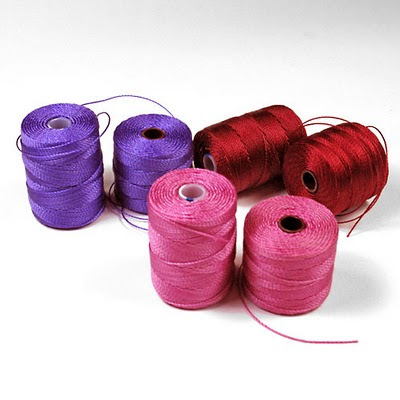
I first encountered the name 'kumihimo' in 1978 at a show when the Kliots, textile specialists from Berkeley exclaimed in front of my exhibit that I was doing kumihimo. I had learned my braiding techniques from a sailor's book on knots. Upon their recommendation, I got their booklet, the first publication in English on kumihimo and a marudai. I tried the marudai but I preferred braiding by hand. I have since played with the disk, mostly for fun...
In July at Convergence in Albuquerque I picked up some hand dyed ribbon with gold metallic to play with. I incorporated this ribbon, C-Lon Bead Cord and 4mm Miyuki Matagamas beads and finished the ends with sterling silver end clasps. The way the Magatamas beads stick out of the braid is fun, but of course you can do this type of braids with regular seed beads.

Materials: Rayon Ribbon, C-Lon Bead Cord, C-Lon Micro Cord, 4mm Miyuki Magatama Beads, 5.8mm inside diameter Kumihimo Sterling Silver End Clasp
Tools: 1 Kumihimo Disk, 8 Small E-Z Bobs, 1 Big Eye Needle, 1 Mini-Clamp, Scissors, Gardening Shears or Heavy Duty Scissors, Poly Zap Super Glue.
Here are the basic steps:
1. Lay 7-strand of ribbon and 1 strand of C-Lon Bead Cord loaded with beads.
For the first braid shown in the foreground, I used 7 strands of ribbon following the dye variations of the ribbon fairly closely so the ribbon strand would shift color at about the same time and 1 strand of C-Lon Bead Cord Medium Purple on which I inserted Magatama beads. I used a mix of two colors: Matte Black AB and of Metallic Dark Blue Iris from Caravan Beads (10 g. tube each). I loaded them at raandom, half of the beads onto the cord with a big eye needle and half way through the braid when I run out, I added the rest.
2. With a piece of C-Lon Micro Cord, tie all the strand together and wrap the end with a tight cork screw type of wrap, finished by a few half-hitches. This end is now ready for the end clasp. Clip the end with a mini-clamp.
3. Lay the 8 strands (7 ribbon strands, 1 C-Lon Bead Cord with the inserted beads) onto the Kumihimo Disk and insert them into the slots.
4. Wrap all the strand individually onto the small E-Z Bobs. For the C-Lon Bead Cord strand with beads have most of the beads inside the E-Z Bob with a few left on the outside ready to pop into the braid.
4. Braid using the very basic 8-strand round braid. After the first half inch, slide a bead in every time when braiding with the C-Lon Bead Cord and 'catch' the bead right behind the last strand.
5. Continue until desired length is achieved, leaving the last half inch without beads. Tie with a piece of C-Lon Micro Cord with a few half-hitches.
6. Remove from disk and make a tight cork screw wrap with the C-Lon Micro Cord, finished with a few half-hitches.
7. Glue the ends with Poly Zap Superglue after making sure the ends diameter fits into your end clasps.
8. Cut the ends with shears right into the glued area.
8. Glue into the end clasps.

Variations with 2 Strands of C-Lon Bead Cord with Beads:
The center braid was done with 6 strands of variegated rayon ribbon with gold metallic accent, 2 strands of C-Lon Bead Cord and 4mm Miyuki Matagama beads
.
I chose Indigo C-Lon Bead Cord with Matte Light Topaz Magatamas and Celadon C-Lon Bead Cord with Matte Sea Glass Green Magatamas interspersed at random with occasional Matte Black AB Magatamas to add a bit of interest. I laid the C-Lon Bead Cord originally on two adjacent quadrants next to each other on the right of #32 and the left of #8.
 Note about the basic round braid
Note about the basic round braid: The basic round braid is made by setting up your strands on the two slots on each side of #32, #8, #16 and #24. Then facing #32, move the bottom left strand up on the left of #31, the right strand down to the right of #15. Then turn the disk counterclockwise a quarter turn (90º) and repeat the same movement: bottom left up, top right down without crossing the center line... and turn the disk counterclockwise... and repeat... bottom left up and top right down... turn counterclockwise...
With this braid once you get started, you do not need to pay attention to the numbers. The strands will actually turn around the disk.
If you stop, either leave 3 strands up to find quickly where to continue or just look at the center to see which 2 strands were the last ones to cross over and continue with the opposite group.
You can make this braid without the beads. One of my customer sent me a picture of a braid made without the beads with a central focal beads made by a local lampwork artist. I lost it in my inbox. As soon as I find it I will post it!
A limited number of Hand Dyed Rayon and Metallic Ribbon, C-Lon Bead Cord & Bead Kumihimo Kits are now available >
New Kumihimo Ribbon & Bead Kits


















